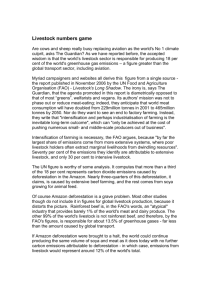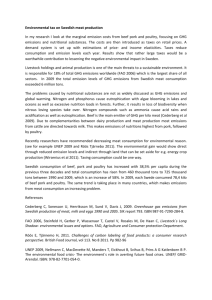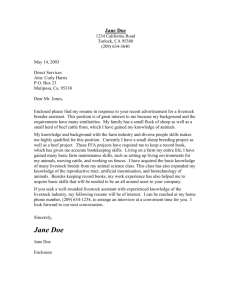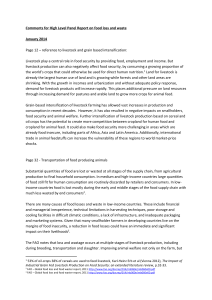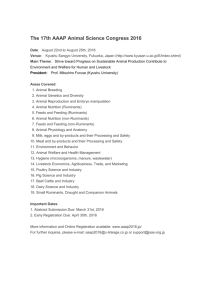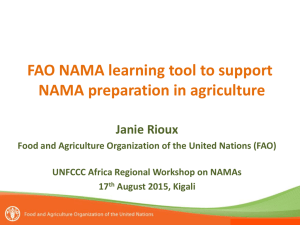World Population - Department of Food Science and Human Nutrition
advertisement
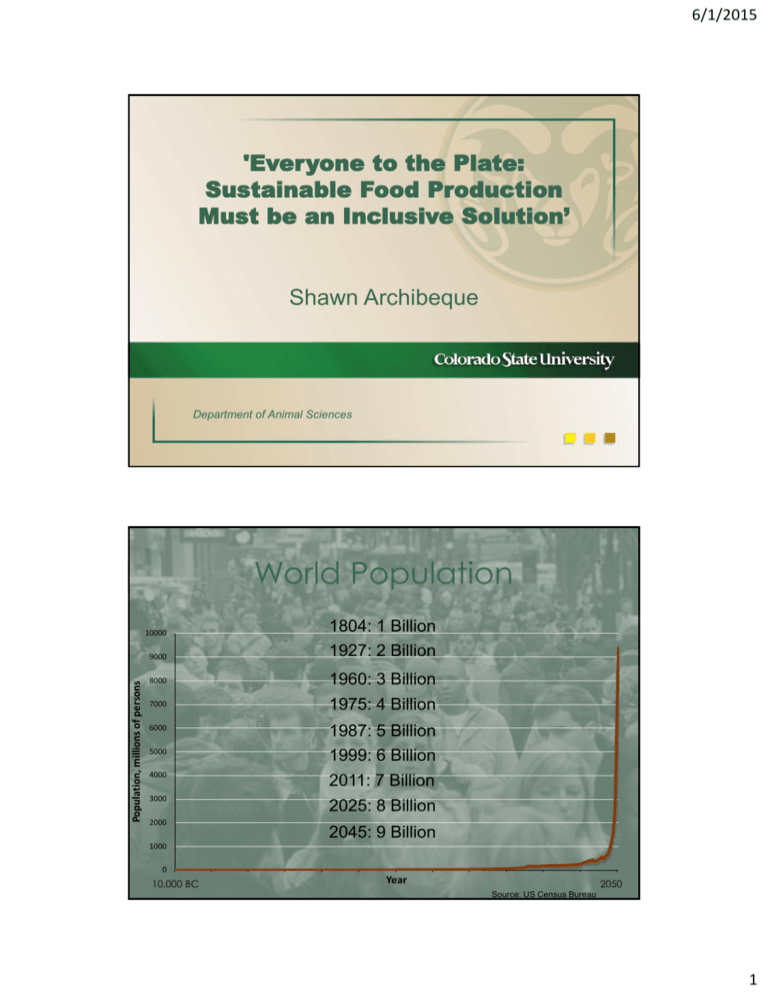
6/1/2015 'Everyone to the Plate: Sustainable Food Production Must be an Inclusive Solution’ Shawn Archibeque Department of Animal Sciences World Population 9000 1804: 1 Billion 1927: 2 Billion 8000 1960: 3 Billion 7000 1975: 4 Billion 6000 1987: 5 Billion 1999: 6 Billion Population, millions of persons 10000 5000 4000 3000 2000 2011: 7 Billion 2025: 8 Billion 2045: 9 Billion 1000 0 10,000 BC Year 2050 Source: US Census Bureau 1 6/1/2015 World Population 9000 1804: 1 Billion 1927: 2 Billion 8000 1960: 3 Billion 7000 1975: 4 Billion 6000 1987: 5 Billion 1999: 6 Billion Population, millions of persons 10000 5000 4000 2011: 7 Billion 3000 2025: 8 Billion 2000 2045: 9 Billion 1000 0 10,000 BC Year 2050 Source: US Census Bureau SUSTAINABILITY = ENVIRONMENTAL IMPACT? No. Economics and social issues must also be considered. 2 6/1/2015 Sustainability… a ‘wicked’ problem Such a problem has the essential characteristic that it is not solvable; it can only be managed. • No clear definition of the problem • No ‘right or wrong’ rather ‘better or worse’ • Stakeholders have different ways of looking at the problem • Causes and effects within the system are complex, unknown and/or highly uncertain Peterson, 2013 Economic Long-term business viability, stewardship of natural resources, and responsibility to community, family, animals Environment Social 3 6/1/2015 4 6/1/2015 Temperature and CO2 concentration Temperature and CO2 concentration 5 6/1/2015 Current CO2 concentration higher than past 650,000 years Source: http://climate.nasa.gov/evidence/ Global Warming Potential Carbon Dioxide CO2 1 Methane CH4 Nitrous oxide N2O 28 265 6 6/1/2015 Livestock’s Long Shadow “The Livestock sector is a major player, responsible for 18% of GHG emissions measured in CO2e. This is a higher share than transport” (FAO 2006) • Used Life Cycle Assessment 7 6/1/2015 U.S. dairy carbon footprint Life cycle assessment 59% 6% electricity Footprint measured in metric tons of CO2e* 35% manure methane 21% 12% fuel use 59% enteric 24% fertilizer methane 7% 2% refrigerant 23% fuel 64% soil N2O 75% electricity Crop Production Milk Production Processing 7% 35% container formation 65% raw material Packaging 3% 3% 28% refrigerant 100% Diesel Transport/ Distribution 72% energy Retail Enteric methane CH4 Photo Courtesy of Oklahoma State University 8 6/1/2015 Livestock’s Long Shadow • Land use change = 35.4% of GHG emissions – Desertification = 1.4% – Deforestation = 34% Source: Savory Institute 9 6/1/2015 Author's personal copy 21 Clearing the Air: Livestock’s Contribution to Climate Change Land degradation in dr ylands Net loss of forest Figure 8 Current forest cover Net gain of forest National boundar ies Forest transition and land degradation in dry lands (FAO, 2006). Russia and Brazil are home to the largest forested areas accounting for 21 and 10%of the total global forestland, respectively (Dixon et al., 1994). High and low latitude forests contain the largest C pools; hence changes (anthropogenic or nonanthropogenic) to specific forested areas can have a greater 10 6/1/2015 Author's personal copy 12 Maurice E. Pitesky et al. Livestock units per square km 0 0.1–0.5 0–0.1 0.5–1 1–2.5 >2.5 National boundar ies Figure 4 Global estimates of aggregate distribution of pigs, poultry, cattle, and small ruminants (FAO, 2006). fermentation isthesecond leading source of GHG from livestock. Therefore, when evaluating LLS(FAO et al., 2006) with respect to GHGs, domesticated ruminants are the primary species studied. However, it is important to recognize the significance of other nonruminant livestock. For example, in the United States swine are the second greatest source of CH 4 and N 2O emissionsfrom manuremanagement and havehad aCH 4 and N 2O emissions increase of 34%between 1990 and 2006 (EPA et al., 2006). In addition, pork and poultry production currently consume over 75% of cereal and oil-seed based on concentrate that is grown for livestock (Galloway et al., 2007). Therefore, while ruminantsconsume 69% of animal feed overall, nonruminatesconsume 72%of all animal feed that isgrown on arable land (Galloway et al., 2007). Consequently, while enteric fermentation from nonruminantsis not a significant source of GHG, indirect emissionsassociated with cropland dedicated to nonruminant livestock might be significant. • LLS global assessment, should not be The typesisofaLPSs utilized are typically based on socioeconomics, applied regionally tradition, and available resources. LLS states that extensive (i.e., grazing animals)–and intensive (i.e., animals are contained and feed is brought to US: 3.4% of GHG emissions them) LPSsemit 5000 and 2100 Tg CO 2-eq yr 1, respectively (FAO et al., – Paraguay: ~50%numbers are not normalized to a per animal 2006). While these emissions unit scale, the type of production system utilized (i.e., landless vsgrassland) – Ethiopia: ~90% affects direct (i.e., from the animal) and indirect (i.e., emissions associated Transport was not analyzed with LCA with• livestock) emissions quantitatively and qualitatively. For example, the method low animal density coupled with high land areautilized by extensive systems Provi ded fo Not r non-co for m m repr This oduc ercial re ch tion, se publish apter w distri arch an as bene ed by El original bution d educ fit at educ and for sevier, an ly publish or co at d th mmerional use send ional use e benefit the atta ed in the cial us only. ing it ched book includ of th institu co Ad to e e. tion’ specific ing with author's py is prov vances in ou s adm co in inistra lleagues t limitatio stitution, ided by El Agronom y, w se tor. ho kn n use in for no n-co vier for Vol. 10 ow yo in u, an structio mmerci the auth 3, or's n at d prov al iding your in research and a copy stitutio n, to yo ur Clearing the air… All ot he reprin r uses, re prod ts, personselling or uction an perm al or insti licensing d distrib ut issio n may tution’s copies or ion, incl web ud ac be http:// sought site or re cess, or po ing with ou fo www po sti From .else r such us sitory, ar ng on opt limitatio : Mau vier.c Clea e n ric om/lo through e prohibite en intern commer edito ring the e E. Pite Else et cial cate/p d. r: Ad A ermiss vier's pe For exce sites, your vanc ir: Live sky, Kim stock es in be ptio ionuse rmiss rly ’s Agro mater ions sit ns, nomy, Contrib R. Stackh e at: ial ut ouse Vol ion ISBN . 103, Bu to Climat , and Fran kM © Co : 978-0- rlington: e Chan ge. In . Mitloe pyrig 12-3 A ca hn demic ht 74 D Press, onald Sp er, Acade 2009 Else 819-5 mic Pr vier In 2009 arks, , pp. c. ess. 1-40 . 11 6/1/2015 New UN FAO report • 14.5% of global anthropogenic GHG • Regions with more modern, intensive production systems have lower GHG emissions per unit of beef What is missing from the ‘debate’? -Context. Less than 1% of solar energy is captured by photosynthesis 12 6/1/2015 Cellulose Most abundant organic compound on the planet… yet, humans cannot digest it. 13 6/1/2015 US Beef production 30 Beef Production, billions of lbs 25 20 15 10 5 0 1930 1940 1950 1960 1970 1980 1990 2000 2010 Year Beef production and cow inventory 30 Beef Production, billions of lbs 25 20 15 10 Produce same amount of beef with 30% fewer animals 5 0 1930 1940 1950 1960 1970 1980 1990 2000 2010 Year 14 6/1/2015 Historical context -16% -18% Production efficiency: More with less -33% -12% -19% -30% 0% 20% 40% 2007 60% 1977 80% 100% Capper, 2011 JAS 89:4249-4261 Production efficiency considerations • Reproductive efficiency • Animal health • Genetics • Nutrition • Growth promoting technologies Photo Courtesy of Oklahoma State University 15 6/1/2015 Food insecurity - Global 2011-2013 1 in 8 people world-wide were suffering from chronic hunger • 842 million people Food security has national security implications… 16 6/1/2015 Food insecurity - US Ruminant Digestion A. Herbivores – Largest % of herbivores B. Use the world’s largest CHO source for energy C. Evolution – Available food – Safety 17 6/1/2015 The Ruminant Digestive System Sheep Food Supply Polar caps, swamps, deserts, very high mountains 12% 75% Water 10% Too cold, wet, rocky, steep, dry, paved, etc. 3% Tillable 18 6/1/2015 Animal Ag & The World • Increase in human population • Socio-economic status and meat consumption • Animal Ag and competition with humans – Alternative feeds/water – Edible feeds not fit for humans – Feed on non-arable lands What does it mean? • In ruminants, microbial fermentation precedes enzymatic digestion and intestinal absorption • Non-competitive feeds • Extensive use of forages • Byproducts 19 6/1/2015 Long History of Waste Use • • • • Desert ruminants Pastoral societies Potato Famine Commercial Food – Yellow Grease – Brewers Grains – Bakery Waste – Etc. U.S. Cattle Industry • Approximately 33% of beef cattle population enters a feedlot • Enter at 314 kg • Exit at 573 kg (45% of mass in feedlot) • Very visible • Concentration of nutrients – Odor, N, and P 20 6/1/2015 Challenges • Nutritional needs of cattle • Ethanol production – Reduced corn availability – Increased competition for “other” feeds – Distillers grains • Nutrient balance/waste production Potential • Low- moderate quality forages • Distillers grains supplements • Improve nutrient availability for forage-fed ruminants • Determine optimum levels of distillers grains to optimize production • Utilize forages to improve manure value – N:P ratio 21 6/1/2015 Conclusions • We have to use a variety of methods to produce food for future generations • Balance of dietary plans • Focus will be on efficient nutrient use • Current methodologies may change • Sustainability is a complex issue and not as clear cut as many believe Questions? 22
